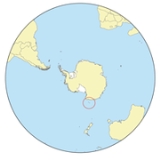
Young Island
Encyclopedia
| Young Island | |
|---|---|
| . | |
| Elevation Elevation The elevation of a geographic location is its height above a fixed reference point, most commonly a reference geoid, a mathematical model of the Earth's sea level as an equipotential gravitational surface .... : |
1340 m (4,396.3 ft) |
| Coordinates: | 66.42°S 162.45°E |
| Location: | Subantarctic island |
| Type: | Stratovolcano Stratovolcano A stratovolcano, also known as a composite volcano, is a tall, conical volcano built up by many layers of hardened lava, tephra, pumice, and volcanic ash. Unlike shield volcanoes, stratovolcanoes are characterized by a steep profile and periodic, explosive eruptions... |
| Last eruption: | Unknown |
| First ascent First ascent In climbing, a first ascent is the first successful, documented attainment of the top of a mountain, or the first to follow a particular climbing route... : |
Unknown |
| Easiest route Mountaineering Mountaineering or mountain climbing is the sport, hobby or profession of hiking, skiing, and climbing mountains. While mountaineering began as attempts to reach the highest point of unclimbed mountains it has branched into specialisations that address different aspects of the mountain and consists... : |
Unknown |
Young Island (66°17′S 162°25′E) is the northernmost and westernmost of the three main islands in the uninhabited Balleny Islands
Balleny Islands
The Balleny Islands are a series of uninhabited islands in the Southern Ocean extending from 66°15' to 67°35'S and 162°30' to 165°00'E. The group extends for about in a northwest-southeast direction. The islands are heavily glaciated and are of volcanic origin. Glaciers project from their slopes...
group located in the Southern Ocean
Southern Ocean
The Southern Ocean comprises the southernmost waters of the World Ocean, generally taken to be south of 60°S latitude and encircling Antarctica. It is usually regarded as the fourth-largest of the five principal oceanic divisions...
. It lies 8 kilometres (5 mi) northwest of Buckle Island
Buckle Island
Buckle Island is one of the three main islands in the uninhabited Balleny Islands group located in the Southern Ocean. It lies northwest of Sturge Island and southeast of Young Island, some north-northeast of Belousov Point on the Antarctic mainland....
, some 115 kilometres (71.5 mi) north-northeast of Belousov Point
Belousov Point
Belousov Point is an ice-covered headland forming the southern tip of the Anderson Peninsula, located just north of the terminus of Suvorov Glacier. It was mapped by the Soviet Antarctic Expedition of 1958 and named for the Soviet polar captain Mikhail P. Belousov, 1904–46....
on the Antarctic mainland.
The island is roughly semi-oval in shape, with a long straight east coast and a curved west coast meeting at Cape Scoresby in the south and Cape Ellsworth in the north. The distance between these two capes is 11 kilometres (6.8 mi), and at its widest the island is 3.5 kilometres (2.2 mi) across. The island is volcanic, with active fumaroles, and a height of 1340 metres (4,396.3 ft). It is entirely covered with snow.
Several small islets lie in the channel separating Cape Scoresby and Buckle Island, the largest of which is Borradaile Island
Borradaile Island
Borradaile Island is one of the Balleny Islands. It was the site of the first landing south of the Antarctic Circle, and features the "remarkable pinnacle" called Beale Pinnacle, near Cape Beale on its south-eastern coast, and Cape Scoresby on its north-western coast.-Exploration:Borradaile Island...
. Several rock
Rock (geology)
In geology, rock or stone is a naturally occurring solid aggregate of minerals and/or mineraloids.The Earth's outer solid layer, the lithosphere, is made of rock. In general rocks are of three types, namely, igneous, sedimentary, and metamorphic...
stacks lie off the island's northern tip. These are known as the Seal Rocks.
The island forms part of the Ross Dependency
Ross Dependency
The Ross Dependency is a region of Antarctica defined by a sector originating at the South Pole, passing along longitudes 160° east to 150° west, and terminating at latitude 60° south...
, claimed by New Zealand
New Zealand
New Zealand is an island country in the south-western Pacific Ocean comprising two main landmasses and numerous smaller islands. The country is situated some east of Australia across the Tasman Sea, and roughly south of the Pacific island nations of New Caledonia, Fiji, and Tonga...
(see Antarctic territorial claims).
See also
- Antarctic Treaty SystemAntarctic Treaty SystemThe Antarctic Treaty and related agreements, collectively called the Antarctic Treaty System or ATS, regulate international relations with respect to Antarctica, Earth's only continent without a native human population. For the purposes of the treaty system, Antarctica is defined as all of the land...
- Composite Antarctic Gazetteer
- List of Antarctic islands south of 60° S
- SCARScientific Committee on Antarctic ResearchThe Scientific Committee on Antarctic Research is an interdisciplinary body of the International Council for Science . It was established in February 1958 to continue the international coordination of Antarctic scientific activities that had begun during the International Geophysical Year of 1957-58...
- Territorial claims in Antarctica

